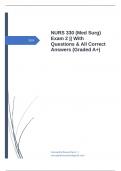NURS 330 (Med Surg)
2024 Exam 2 || With
Questions & All Correct
Answers (Graded A+)
Conceptial Researchers ||
conceptialresearch@gmail.com
, NURS 330 (Med Surg) Exam 2 || With
Questions & All Correct Answers
(Graded A+)
what is enteric precaution? - ANSWER - contact precaution (gown, gloves, hand
hygeine) + handwashing with soap and water
reverse isolation is used for - ANSWER - cancer patient or immunocompromised
patients whose neutrophil levels are dangerously low
what are reverse isolation? - ANSWER - - wear mask, gown, and gloves to avoid
getting the patient sick, not yourself
- cannot have fresh fruit, veggies, or flowers in the room because they may carry
bacteria
When to use special airborne precautions? - ANSWER - coivd-19
what to do for special airborne precuations? - ANSWER - - airborne precuations +
eye protection
Assessment of someone with C diff - ANSWER - vital signs, fever, HR, abdominal
assessment, I and O, is patient able to eat and drink, stool sample, characteristics of
output
nursing dx for c diff - ANSWER - risk for c diff infection, deficient fluid volume r/t
active fluid volume loss aeb 7-10 episodes of diarrhea
planning for c diff - ANSWER - client will be the end of my shift have less episodes of
diarrhea, more formed consistency of stool, and incrase fluid intake to avoid fluid
deficiency
interventions for c diff - ANSWER - education patient and family to wash hands and
how to avoid getting infected
assessment for influenza - ANSWER - vital signs, RR, lung sounds, using accessory
muscles, nasal flaring, respiratory exam, diagnostic testing, previous exposure to
influenza
nursing dx for influenza - ANSWER - risk for infection; social isolation; risk for
pneumonia; difficulty swallowing or eating; decreased appetitie; potential air
exchange issues
planning for influenza - ANSWER - goals for coughing, respirations, fatigue, appetite,
and social isolation
,interventions for influenza - ANSWER - continuing or discontinuing other
medications, educate patient and family on hand washing and droplets, disinfecting
envrionment
assessment for HIV - ANSWER - vital signs, swollen lymph nodes, fever, sore throat,
malaise, skin assessment (rash), rapid testing, lab work, assessing for tumors, sings
of needlestick, social history and past medical history
nursing dx for HIV - ANSWER - psychosocial fear and loneliness; ineffective
protection; risk for infection
planning for HIV - ANSWER - client will be able to explain precautions they need to
take to prevent infection; avoid exposure to other infections
interventions for HIV - ANSWER - educate on protecting themselves from infection;
monitor signs and symptoms of infection; education around safe sex and drug use;
screening on blood products and prenatal screening; educate family
Covid 19 disparities - ANSWER - racial disparities and health care deficits in rural
populations
health care deficits __________ covid 19 in rural communities; nearly ______% of
NC/s population reside in rural community. The number per capita received by
_________ population were consitently lower than the rate for non ______ and
_______ populations - ANSWER - increase; 40%; latino; non latino black; white
infection control and prevention: covid-19 - ANSWER - - screen everyone entering
health care facilities
- nurses should wear facemasks at all times
- physcial distancing
- eye protection
- masks
- hand hygiene
what does MRSA, VRE, CRE, and VRSA stand for? - ANSWER - - methicillin
resistant S. aureus
- Vancomycin resistant enterococci
- Carbapenem resistant Enterobacteriaceae
- vancomycin resistant S. aureus
acutal problem as _______ while risk for a problem is without ______ - ANSWER -
AEB
endemic - ANSWER - constant presence of a disease or infectious agent within a
given geographic area.
epidemic - ANSWER - regional outbreak of a disease that is in excess of what was
expected
, pandemic - ANSWER - Disease that occurs over a wide geographic area and affects
a very high proportion of the population.
ex: malaria and covid-19
routine practices to break the chain of infection - ANSWER - - hand hygiene
- PPE
- keeping open and draining wounds covered
- envrionmental controls
- clothes and household linens should be washed on a regular basis
- need to wash hands after caring or playing with pet
precautions: standard - ANSWER - strategy for assuming all patients may carry
infectious agents and using appropriate e barrier precautions for all healthcare
worker-patient interaction
what to do for standard precautions? - ANSWER - - hand hygiene
- needlestick prevention
- gloves and other PPE should be worn prior to contact with patient where secretions
or excretions are possible
precautions: transmission based - ANSWER - used in addition to standard when
contagious or epidemiologically significant organism are recognized
what are the three types of transmission based precuations? - ANSWER - airborne,
droplet, and contact
When do you use contact precuations? - ANSWER - - MRSA, VRE, CRE
- major pressure ulcers, skin infections (scabbies), and shingles
what to do for contact precuation? - ANSWER - hand hygiene, gloves, and gown
When do you use droplet precuations? - ANSWER - - Haemophilus influenza type B
- neisseria meningitids disease
- pertussis
- atypical pneumonia (mycoplasma)
- adenovirus
- influenza
- mumps, rubella
- penumonia
- sepsis
- epiglotitis
what does droplet precaution mean? - ANSWER - - hand hygiene and surgical mask
within 3 feet of patient
- if suspected contact with pateitn or contminated linen: gloves and gown
- door can remain open
When to use airborne precuations? - ANSWER - - presumed or proven TB




